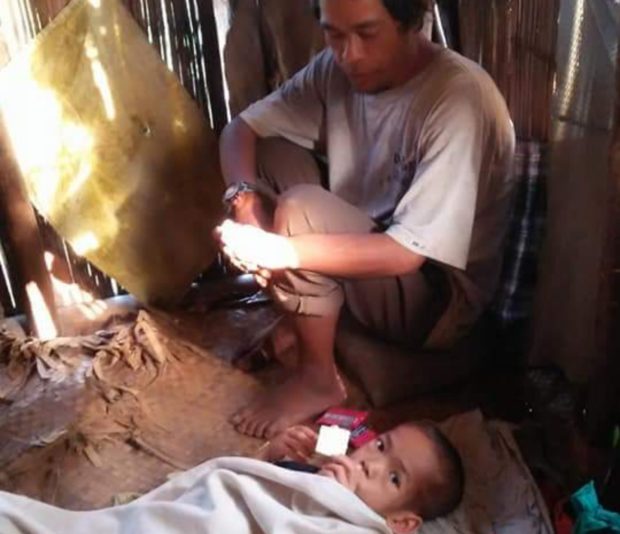Zambo del Sur’s Jonathan Oya: The face of severe malnutrition

TOO WEAK FOR SCHOOL Winnie Oya sits beside his frail son, Jonathan, 12, inside their house in a remote area of Barangay Cogonan in Labangan, Zamboanga del Sur province. —IRENE CABIASAN
PAGADIAN CITY — A few days before he died, Jonathan Oya weighed just 15 kilograms, which was ideal for a 4-year-old. He was 12.
Malnutrition didn’t stop him from walking three hours a day from home to school and back so he would not miss his classes at Glab Elementary School, where he was a Grade 5 student.
But one day last week, Jonathan, a Subanen lumad, failed to show up in school. It was the first time that he missed classes and when his absence stretched to almost a week, his teachers were alarmed.
They knew the boy was determined to learn and went to school every day despite hunger. And school was the only place where he could get a meal once a day.
Difficult journey
Article continues after this advertisementThe teachers and other school officials decided to go to Jonathan’s home at Cogonan village in Labangan town, Zamboanga del Sur province, to check on the boy.
Article continues after this advertisementThere, they found an emaciated Jonathan, too weak to even stand up.
Joel Arnejo, head of Glab Elementary School, said he and other school officials decided to take Jonathan to a hospital in Pagadian City, a difficult journey that took more than eight hours.
Two days after he was brought to the hospital, Jonathan died of complications from severe malnutrition. His death magnified the tragedy of the malnutrition that afflicts children in the hinterlands of Labangan.
Faye Reyes, a coordinator for the World Bank-funded nongovernment organization CheckMySchool, said the Oya family was so poor that Jonathan went to school every day on an empty stomach.
Only meal
“His only hope for a decent meal was the free meal given by the school through its feeding program,” Reyes said.
Jonathan’s father, Winnie, who is in his 50s, tended a small farm and earned barely enough to feed his big family. He has 13 children.
His mother was jobless, according to Arnejo.
Arnejo said the Oya family lived way below the poverty line but was not a beneficiary of the government’s Pantawid Pamilyang Pilipino Program (4Ps) or any other poverty-reduction program of the national government.
It’s unclear why the Oya family is not on the town’s 4Ps list, which village officials helped prepare.
But Labangan officials said the Oya family was on the list of recipients of the local government’s Assistance to Individuals in Crisis Situation Fund allocated for indigent families.
Not isolated
Arnejo said Jonathan’s case was not isolated. At Glab Elementary School alone, he said, 26 of the 154 students suffered from severe malnutrition.
“They are among the beneficiaries of the school’s feeding program,” Arnejo said.
Dr. Mailyn Manupac, the Labangan health officer, said health workers were trying to deal with malnutrition in the town’s 25 villages.
Citing government data, Manupac said cases of malnutrition in the fourth-class town of 41,790 people had been on the decline since 2015, when the malnutrition rate was 14 percent.
In 2017, she said, the malnutrition rate fell to a little more than 7 percent.
Poverty is so pervasive in remote villages of the town that those trying to deliver health services to the poor, community volunteers, are “themselves struggling day-to-day” to survive, she said.
In 2017, Manupac said the Labangan municipal government held a nutrition congress and a summit for health workers to deal with malnutrition among children in the town.
Pahad Abbas, the municipal tourism officer, said a local health board meeting was held recently during which Mayor Eduardo Relacion announced the setting up of a satellite office of the rural health unit for villagers in remote areas.